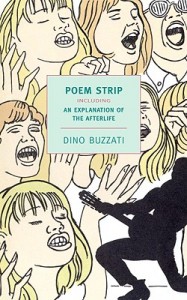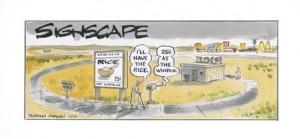Wednesday, January 26, 2011
 The venerable Bill Boichel has done it again. He has possibly unearthed the real secret origin of Spider-Man. Over on his Copacetic Comics site, he has posted a Harry Lucey story from Archie #126 published in March of 1962. He posits that Harry Lucey… err, wait, let me just cut and paste what Bill sez. Or just go to his site – which you gotta do anyways to read the Harry Lucey comic he’s riffing on. Please enjoy.
The venerable Bill Boichel has done it again. He has possibly unearthed the real secret origin of Spider-Man. Over on his Copacetic Comics site, he has posted a Harry Lucey story from Archie #126 published in March of 1962. He posits that Harry Lucey… err, wait, let me just cut and paste what Bill sez. Or just go to his site – which you gotta do anyways to read the Harry Lucey comic he’s riffing on. Please enjoy.
“Here for your consideration is the six page story, ‘Follow the Bouncing Ball’ from Archie Comics #126, with a publication date of March 1962. Produced by the peerless penciller, Harry Lucey, this story appeared on the stands five or six months before Amazing Fantasy #15 (AF15 had a cover date of August, but states September 1962 in the indicia).
“This story involves the accidental introduction of radioactivity into a high schooler’s life, with supernatural results. Not only that, but the throwaway gag panel that concludes the story introduces the concept of the so-gained supernatural power interfering with the teen’s normal romantic life, which is a central theme to Spider-Man, and critical to the long lasting success of the character. And then there’s the use of the word ‘tingling’ which came to be associated with Spider-Man’s ‘spidey-sense.’ It kinda of makes you wonder…
“Zeitgeist? Coincidence? Or, perhaps, this story was read by Stan and/or Steve during a lunchbreak, leading to the conscious or unconscious sparking of an idea. The timing is just right. We’ll never know, of course, but it’s something to ponder. Now’s your chance to read it for yourself, and see what you think.”
Wednesday, January 26, 2011

The 2009 translation and republication of Dino Buzzati’s Poem Strip (originally published as Poema a Fumetti in 1969) hasn’t received the attention it merits, I think. The book is interesting on a number of grounds: as I’ve noted earlier, it belongs to the tradition of the proto-graphic novel; Buzzati himself was an important writer and artist, and the book makes a fine appetizer for his larger artistic career; the themes and artistic techniques explored in the book are also intriguingly connected with other cultural developments of the 1960s.
Read More…
Wednesday, January 26, 2011
 This is truely a “drop everything and take a look” moment. Justin Green, onetime contributer to the print version of Comics Comics as well as all round underground comix genius, has just started a blog. So far, he hasn’t written anything but has posted three cartoons. I’m not sure but it looks like the blog might be an archive of Green current cartooning, which is a very nice thing to have. (Thanks to Brad Mackay for pointing this out to me).
This is truely a “drop everything and take a look” moment. Justin Green, onetime contributer to the print version of Comics Comics as well as all round underground comix genius, has just started a blog. So far, he hasn’t written anything but has posted three cartoons. I’m not sure but it looks like the blog might be an archive of Green current cartooning, which is a very nice thing to have. (Thanks to Brad Mackay for pointing this out to me).
Tuesday, January 25, 2011

Just a collection of faces by Roberto “Magnus” Raviola, from Catalan Communications’ 1987 edition of The Specialist: Full Moon in Dendera, one of the later (1982) installments of the artist’s Lo Sconosciuto, your typical international man of danger. By that time, the Unknow(n) title character had moved to the back of his own stories, functioning in Dendera as a Golgo 13 type of character who zooms in and out of the action, finally shooting a bunch of people to resolve the ambling plot. So, mostly, it’s an excuse for Magnus to draw a number of smooth, detailed, splendid characters discussing ancient Egyptian art and culture, and engaging in extremely dense political games. Maybe Catalan felt it gave the work more of a ‘literary’ quality – or maybe that was all they had access too? Mostly they published albums of Magnus’ erotic Necron series, leaving the Specialist rather unique indeed.
And:
Read More…
Saturday, January 22, 2011
I’m sitting in Ron Regé Jr’s apartment in Echo Park. Morning time. There is a woman below the window who is clipping, pruning the green around the white flowers. Lots of birds. Sun. I miss the sound of birds outside my window. Just the lonesome raven calls out in the desert of New Mexico.
I’ve been here 3 nights so far and Ron has been kind to host. He lives in a second story apartment in one of those pre-war white adobe corner jobs. There’s four units and it feels quite comfortable if you know and like your neighbors – and Ron does. He said it’s like Three’s Company. The other day people just started stopping by. “This never happens,” Ron said. One after another long lost friends were appearing in the little apartment. Just as one would leave another would drop by. It was like a rolling party. It never stopped for two whole days. The second day was even funnier because a photo shoot was happening next door. So there was a make-up trailer parked outside with loads of pretty girls parading up and down the stairs. Unfortunately, I had slept through most of it – exhausted from the earlier parade.
I rummaged through Ron’s zine collection. I found a few CF zines, a Rozz Toxx manifesto, some Kaz Strepak zines, and Ron’s Cambridge Massachusettes city sponsered teen anti-drinking scratch-off postcard.
Friday, January 21, 2011

Now THAT is an angle.
Goaded by Santoro I had planned to write a post on Jack Kirby’s collage work. Lucky for you, I didn’t. Instead I have this:
1) My biggest comics thought in the last week has been about Deadpool. I read issues 1 and 3 and was “dismayed” by its transparent attempts to shock, it’s sub-Apatow humor, and cynical Tarantino x 10000 retread of outre tropes and “dirty” sex jokes anchored by some deeply strange but very uneven artwork and not any kind of satire and certainly not good comics. It’s trying to be funny, but instead, like Lapham’s Stray Bullets, it just makes the motions of a genre without having any gravitas or unique ideas underpinning it. So naturally I wrote a heartfelt email to Jog pleading with him to explain to me why I should care about this series. Why? He didn’t try to convince me. But I do find Baker’s artwork interesting because, as Jog said in his email: “My interest is mostly in seeing Baker contort his weird digital style into something increasingly po-faced and funny in the ‘funny pictures’ sense. I like that Deadpool constantly looks like an action figure – it feels like a presence that needs to exist on the Marvel scene, which is heavier than ever on posed, ‘realist’ shiny art.” Yes, with this I agree.
2) I have yet to see this posted anywhere, but here’s the Wall Street Journal weighing in on the recent upheavals at L’Association. It offers a pretty good overview and ties in the OuBaPo comics movement, which I’d never really considered in this context. I kind of love the Jerry Lewis reference in the headline while also hating it, but mostly because the confluence of Jerry Lewis and comics makes me think of Bob Oksner, and that makes me smile.
3) Over on Facebook someone posted a bunch of Neal Adams Ben Casey Sunday pages from 1964. I don’t think I’ve ever seen them and, man, is there some amped-up drama in there. I hadn’t realized that Adams was working those massive figures and impossible angles so early. It’s Stan Drake on steroids and I like it.
And that, my friends, is that. Happy weekend!
Thursday, January 20, 2011

Tonight in sunny Los Angeles our own Frank Santoro is opening an exhibition of new drawings. Go see him (yes, he’ll be there!) and be sure to ask him about Scorpio Rose. That works every time. I got to see a bunch of the work in progress when I was in Pittsburgh last September and this stuff really is stunning. You’re in for a real treat. I posted a preview over on PBox, and here’s the info:
DEM PASSWORDS
7914-B SANTA MONICA BLVD T. 772.202.2733
WEST HOLLYWOOD, CA 90046
Opening Reception: Thursday, January 20th, from 7 to 10pm
Thursday, January 20th – Friday, February 18th , 2011
Wednesday, January 19, 2011
About a year ago, Ng Suat Tong invited me to help judge his annual online comics criticism event. Not seeing a good reason against it at the time, I agreed. (As you may remember, Frank participated last time around.) It was definitely an imperfect exercise, but I knew that going in. More on that later.
First, the winners, as listed by Suat here. (He also provided commentary on the panel as a whole and some of the runners up.)
1. “The Other Love That Dare Not Speak Its Name”, by Jason Thompson (6 votes)
I was apparently the only judge who didn’t vote for this article, which surprises me. Not because Thompson’s article is poor—in fact, I think it is a fine overview of an exotic (to Americans) cultural subject—but because it doesn’t seem to me to be criticism at all. The closest thing to a critical judgment that I can find in the essay comes in the summing-up statement: “In short, although a few artists like Moto Hagio write serious stories about the consequences of incest and child abuse, most manga and anime creators flirt with incest for kink, comedy and emotional effect.” Not exactly an electrifying insight.
Still and all, if this had been a competition designed simply to identify 2010’s best writing about comics on the internet, I may well have voted for this. But it wasn’t, and I didn’t.
Read More…
Wednesday, January 19, 2011

Captain Israel: A Hero for Our Times?
I try to refrain from political discussions on this blog but this Mondoweiss post about a Captain Israel comic book will, I think, be of interest to readers of this blog. In an earlier essay on Canadian comic book history, I touched on the relationship between superheroes and nationalism.
I think my earlier comments might shed light on this topic:
Moreover, Superman, like the superhero genre he spawned, is a profoundly American idea. Superman was created at a turning point in American history, during the Great Depression. Economically debilitated, the U.S. was isolationist, but in a few short years it was ready to recover its strength and become the world’s leading superpower. Just as wimpy Clark Kent threw away his business suit to emerge as Superman, America was a great power waiting to flex its muscles. Joe Shuster and Jerry Siegel, Superman’s creators, were second-generation immigrant Jews. As such, they had multiple reasons for identifying with American nationalism; deep in their bones, they felt that only a superpower could defeat Hitler.
Ingrained in the superhero genre is a sense of America’s invincibility, its inherent goodness and its world historical destiny. For this reason, national heroes from other countries (be they Captain Canuck, Britain’s Jack Staff, Italy’s Capitan Italia or Israel’s Shaloman) always seem either satirical or half-baked. Despite the faltering war effort in Iraq, the U.S. is the world’s only superpower and for that reason it is the only country that creates confident and commercially successful superheroes.
Wednesday, January 19, 2011

A photo you can stare at for hours.
Daniel Clowes has never made a secret of his Wally Wood fixation. Wood’s life and career, in all its lurid glory and splendid squalor held a particular fascination for Clowes when the younger cartoonist was starting out, a fascination that continues to this day. One example worth calling attention to: compare Gil Ortiz’s amazing photograph of Wood sitting by a typewriter (found here)with the back of the cover Clowes did for Ivan Brunetti’s An Anthology of Graphic Fiction, Cartoons, and True Stories, volume 2. The large panel with the cartoonist sitting on his bed is clearly inspired by the Ortiz photo.
The entire cover, a fine example of Clowes’ recent move into fragmented storytelling, calls out for a Parille-ite close reading. Briefly, the large panel with the cartoonist on the bed is, I think, the central scene. All the major graphic elements for the front cover and the various smaller fragments are taken from stuff the cartoonist sees in his room. The whole page is about the relationship between the limited physical space a cartoonist works in (the squalid room) and the products of his imagination. This relationship shows elements of both discrepancy (the images the cartoonist draws are more romantic than the reality) as well as linkage (the graphic elements of what the cartoonist draws are taken from stuff around him). Especially interesting is the fact that the cartoon Ivan Brunetti is nothing like the actually existing Brunetti: the cartoonist only deals with the editor through the phone and has an unreal (and hyper-exaggerated) image of what the editor is like.

Clowes cover.
 The venerable Bill Boichel has done it again. He has possibly unearthed the real secret origin of Spider-Man. Over on his Copacetic Comics site, he has posted a Harry Lucey story from Archie #126 published in March of 1962. He posits that Harry Lucey… err, wait, let me just cut and paste what Bill sez. Or just go to his site – which you gotta do anyways to read the Harry Lucey comic he’s riffing on. Please enjoy.
The venerable Bill Boichel has done it again. He has possibly unearthed the real secret origin of Spider-Man. Over on his Copacetic Comics site, he has posted a Harry Lucey story from Archie #126 published in March of 1962. He posits that Harry Lucey… err, wait, let me just cut and paste what Bill sez. Or just go to his site – which you gotta do anyways to read the Harry Lucey comic he’s riffing on. Please enjoy.














